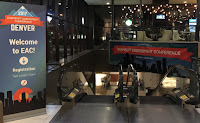And by SpeedPro Denver’s Great. Big. Graphics.
Make it Noticeable
Three out of four shoppers will visit a new store for the first time based on its signage, while many shoppers say a store’s signage is a direct reflection on its product and service quality. Numerous studies from both industry institutions to public research universities drive this point home--your organization’s outdoor signs have the power to increase store traffic.
The
International Sign Association states that a
successful outdoor sign holds four qualities:
- Detectable
- Conspicuous
- Legible
- Comprehensible
Pick an Emotionally Relevant Color Scheme
Decades of research
have gone into understanding color psychology; the science of how certain
colors elicit specific reactions within viewers. Businesses harness color
psychology to pick branded color schemes, selecting colors and shades that
trigger a set of emotions they want to be instantaneously and even
subconsciously associated with. From playful to authoritative, contemporary to
classic, youthful to mature, luxe to price-conscious, colors help convey your
company’s “personality.”
Signs that
are designed using one of three established color-theory
methodologies can boost professionalism, legibility and their overall
appearance:
· Biadic or
triadic color schemes: Biadic or
triadic color schemes pair colors based on their position on the color wheel.
As the root of their names suggest, biadic schemes use two opposing colors,
such as yellow and purple, whereas triadic colors use three colors equally
spaced on the color wheel, such as light orange, purple and green. The results
are high-intensity imagery with natural light and dark components.
·
Gradient
schemes: Also called monochrome
schemes, gradient schemes select one dominant color, then accent it with
various shades of that same color. Signs with gradient schemes may lack the
high-contrast intensity of biadic or triadic color schemes, but they can appear
more polished and luxe.
·
Split
complementary schemes: Split
complementary schemes pair one dominant color with two other colors that sit to
either side of the dominant color’s direct opposite. For example, if the
dominant color is red, the split-complement colors are light green and teal
since those are the colors on either side of the red’s direct opposite, green.
Split complementary schemes lend signs a brighter and more complex color
palette while maintaining high levels of contrast but can take extra work to
balance attractively.
Prioritize
Readability
Is your font easy to read and are you thinking big enough? A
good industry rule of thumb is the 10-by-1 rule, which states one inch of
letter height can generally be read at a maximum of ten feet away.
Consider Using Texture or Depth
Texture
provides contrast for outdoor signage, which increases both its readability and
general appearance. Signs that include these visual elements also have an
easier time distinguishing themselves from the crowd, their detailing allowing
them to pop on the street.
·
Shading: Shading increases letter readability. Signs
can incorporate shading into the design itself through fonts and prints or by
placing lights around the sign to cast strategic shadows.
· Tone and
hue contrast: Contrasting colors
give letters and graphics a natural pop. Signs with contrasting colors using
the methodologies described earlier will naturally increase depth and textures.
· Pop-out
material or textiles: Signs are often tied to the appearance of the 2D
materials they are fashioned from. While this most often includes base
substrates like vinyl and canvas, it can also incorporate elements that look
more 3D, such as contour-cut
signage.
Go Digital
Digital signage shakes up the
conventional, static signs spotted along the street. Since these signs use
screens instead of printed substrates, they are innately brighter and flashier,
plus are more readily customizable. Businesses can easily swap and replace the
text and images on its digital signs without having to install something new
every time branding efforts change.
Digital signs are especially beneficial if your operation
changes its products and services frequently. For example, an ice cream parlor
could advertise its flavor of the day, a restaurant its weekly menu and a gas station
its daily fuel prices and snack specials.
Light It Up
Adding a light source to your signs will turn your outdoor
signage into a 24/7, weatherproof advertising canvas.
The most common backlit signs use LED lights and frames
surrounded by a fabric overlay that serves as your sign’s front face. When
switched on, your sign illuminates text and graphics from the inside out. The
results are enhanced sign aesthetics, clarity and readability, plus one of the
easiest ways to stand out from other signs on the street.
Include a Graphic
More than half of consumers prefer signs containing both
text and graphics, as opposed to only eight percent who prefer text-only
signage. With over 85 percent of consumers saying they glean a company’s
character or personality based on its outdoor signs, including graphics becomes
that much more important.
Researchers believe this success comes down to heuristic
cues. Signs with graphics can relay additional branded information about a
business or service. Compared to text-only signs, graphics are language-less
and have the potential to be instantly recognizable.
Outdoor signage represents your business. It conveys a tone
and a personality, as well as what customers can expect when they step foot
inside your space.
With these
tips in mind, contact SpeedPro Denver
today and
we’ll get started on your new outdoor signage!
denver@speedpro.com 303.426.4199 www.speedpro.com/denver

















